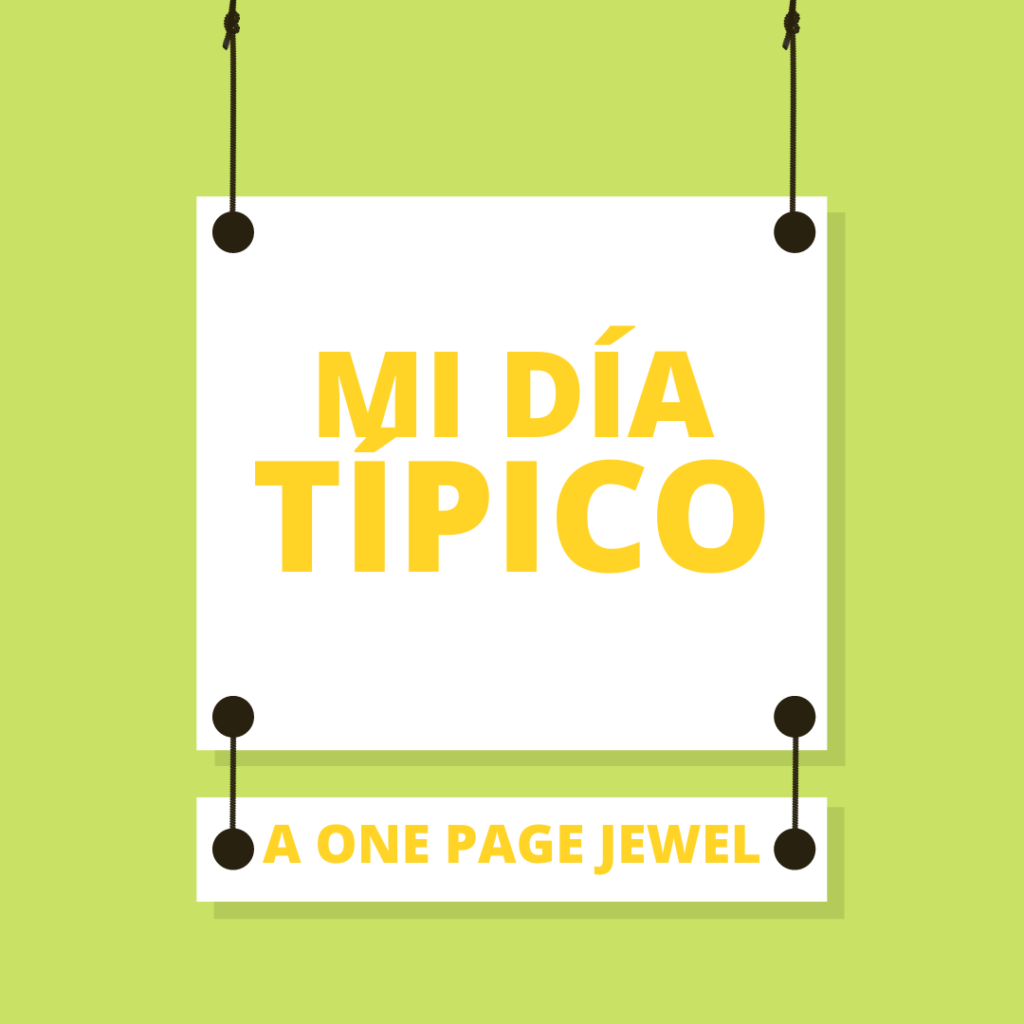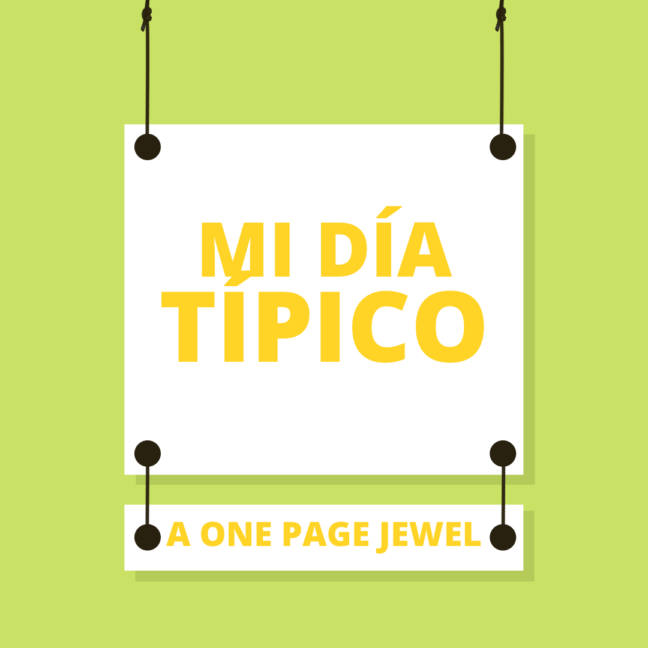You know you have found ‘a jewel’ for a unit when you discover ‘Mi día típico’ by Amy Lenord through Twitter: https://twitter.com/alenord/status/1479988461264416777
It is only one page but it lets you dive into so many topics while personalizing it for each of your students.
Many ways to use ‘Mi día típico’ by Amy Lenord
This one page can be used to review many topics already studied, such as clothing, food, time, sports, meals and food, school, chores and other activities, and grammar structures, such as prepositional phrases, adverbs of quantity, sequencing words, besides the conjugation of verbs in the 1st person singular of regular, stem-changing, and reflexive verbs.
It also gives the perfect context to review the verbs ‘desayunar, almorzar, merendar & cenar’ for the specific meals of the day, as opposed to repeating ‘comer’. This is something quite confusing to language learners as these verbs are used differently in English and in Spanish.
Another application of this great resource is to make comparisons and explore new topics.

How I used ‘Mi día típico’
Reading for understanding
Initially, students read the page, it was easy for them to understand the meaning of the statements by looking at the images Amy Lenord included as a clue, plus my acting out, and drawing when necessary.
Later, I used this page for Interpersonal Speaking, Presentational Writing, and Presentational Speaking.
Interpersonal Speaking
After my fifth grade students read the page multiple times and were familiar with the meaning of each statement, I moved to having them ask and answer questions about themselves. They quickly realized that they needed to change the endings of all the verbs and the pronouns from ‘me’ (about me) to ‘te’ (about you) when asking their partner. There were some giggles when they made the questions without making this change, e.g.: ‘Do you brush ‘my’ teeth in the morning?’ instead of asking ‘Do you brush ‘your’ teeth in the morning?’
Scaffolding in Preparation to Present ‘Mi día típico’
Using the resource for presentational writing and presentational speaking needed some scaffolding. The following are some activities and tasks that my students did prior to presenting.
- Draw the activities
I had students use this ‘jewel’ to also think about their typical days. I handed a booklet with three pages with the days of the week on each page. The first page read ‘Por la mañana’ (In the morning). The second read ‘Por la tarde’ (in the afternoon) and the third one had ‘Por la noche’ (at night), Students drew what they do during each part of the day on the specific days of the week. This booklet, along with the page ‘Mi día típico’, were our anchor for the rest of the tasks and activities. Students used both as guides all along.
- Self-checking competition
I asked students to study the ‘Mi día típico’ verbs and the next day we played a competition. Each student would say a verb and everybody had to write it down. Students numbered the verbs and wrote them down until they thought they had named them all. Then they self-checked their writing against the ‘Mi día típico’ page for spelling and completion of all verbs. To my surprise, not only had they included all the verbs, but they had also added a few more!
- Level up the phrases
Then, students chose one of the drawings from their booklet and wrote a sentence in their notebook that later read aloud to share it with their peers. I have to say that they came up with excellent phrases! To push them a little bit more, I asked them to ‘level up’ the phrases, so we discussed ideas on how to do it. Finally, students practiced ‘leveling up’ their phrases into emerging sentences by writing two more sentences and adding some details. They were very proud to share them in class.
- Topic and conclusion sentences
The next class, We discussed which could be a good topic and a conclusion sentence for a presentational writing assignment and we jotted down several possible sentences. We used OneNote so everybody knew where to find the topic and conclusion sentences to study.
- “We are in RLA,” they said
For reference, RLA is Reading Language Arts. I asked students if they had written paragraphs in Language Arts and they all said ‘Yes’, and we talked about what makes a good paragraph. I asked them to look at their drawings and circle those which they thought could be good illustrations to write about in Spanish. They could choose up to six pictures from any part of their booklet. While they were planning what to write, I told them they should answer: What can I write that will make an impact on Sra.? That way,I would see complete and original thoughts when I read their paragraphs. In other words, their writing had to catch my attention as a reader.
I also told them that we would be writing a presentation in class only using the booklet with the drawings and it would be an assessment. They practiced with different partners until they had a better idea of what they could write about and how they would write it.
Presentational Writing Assessment
It is imperative that I know what students are able to do. It helps me understand what I need to do to move students along the proficiency levels. Using their drawings as the only resource, most of my students included at least a Novice High sentence, evidence that they have already started creating original thoughts in Spanish. As a teacher, I felt accomplished!
Presentational Speaking & Reflection
For the Presentational Speaking they would be recording ‘Mi día típico’ in Flipgrid the following class. In preparation, they chose what to say, they practiced with friends, asked me questions, and shared strategies on how to do it. Then, they completed a reflection about the following:
- What went well for you?
- What was challenging?
- What did you learn about yourself?
- What would you do differently next time?
For the most part, students’ responses showed that the presentational writing was better than the presentational speaking because when writing, you can proofread your text, but when speaking, you have to come up with what to say on the spot. For the most part, they said that they could write and speak in Spanish much better than they could have ever imagined. I was proud of their work, effort, and growth.
I find that ‘Mi día típico’ by Amy Lenord is a resource that helps my students accomplish communication. Thank you, Amy!
